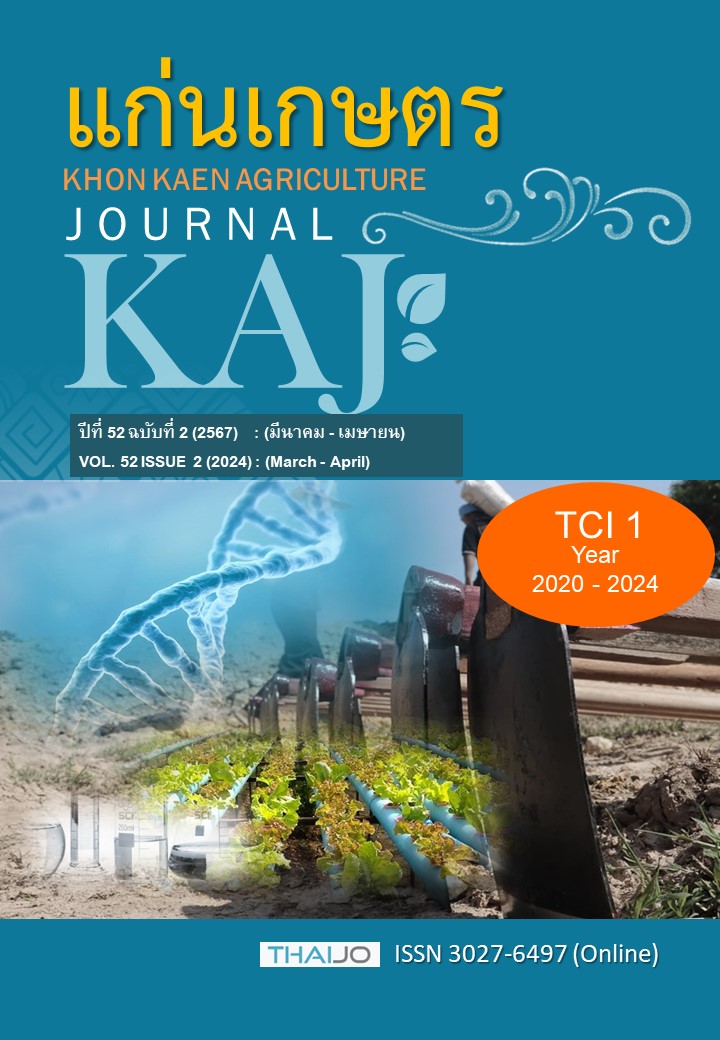Effect of zinc amended fertilizer on yield, microbial quantity and respiration of the cultivated soil of Chinese kale production
Main Article Content
Abstract
This study aimed to investigate the effect of different fertilization among organic fertilizer or organic-chemical fertilizer amended with 3 level of Zn 0, 0.5 and 1% on growth, yield and Zn content of Chinese kale (Bang Bua Thong 35). The field experiment was conducted in Bangkuwat, Muang, Pathumthani during February to April 2023 with an experimental design of 2x3 factorial in completely randomized design (CRD). The different fertilizers were applied at 3rd fertilization to the 30-day-old-Chinese kale. Growth parameters and fresh mass yield were collected at a time of harvesting (44 days) and then the vegetables were tested for Zn content using AAS. Results exhibited that Zn amended fertilizer provided negative effects on plant height and fresh yield for approx. 28%, however, consequent Chinese kale accumulated greater amount of Zn for approx. 22%. The highest yield (9.2 kg/m2) obtained from the co-application of chemical fertilizer and organic fertilizer (1:1) at a rate of 40 g/m-2, while, maximum Zn content in the kale obtained when co-applying of chemical fertilizer and either 1%Zn amended organic- or 0.5-1% Zn amended organic chemical- fertilizer which provided total Zn content of 89.8 and 91.8-98.1 mg/kg Dw, respectively. Moreover, it was found that Zn amended fertilizer provided no effect on total number of soil microorganisms. Nevertheless, the application of 1% Zn organic-chemical fertilizer exhibited a reduction of Zn solubilizing microorganisms after 3 days applying, and then recovered later after 7 days applying. Additionally, the soil respiration rate and soil chemical properties seemed to be slightly affected.
Article Details

This work is licensed under a Creative Commons Attribution-NonCommercial-NoDerivatives 4.0 International License.
References
กัญญ์กุลณัช คำปวง, สิทธิเศวตร์ ลอดแก้ว และชนากานต์ เทโบลต์ พรมอุทัย. 2564. ผลของการจัดการปุ๋ยสังกะสีต่อการเจริญเติบโตในต้นกล้าข้าวพันธุ์ชัยนาท 1 และก่ำดอยสะเก็ดที่เพาะในวัสดุปลูกขี้เถ้าแกลบ. แก่นเกษตร. 49(4): 810-817.
กรมวิขาการเกษตร. 2548. คำแนะนำการใช้ปุ๋ยกับพืชเศรษฐกิจ, กระทรวงเกษตรและสหกรณ์, กรุงเทพฯ.
คณะกรรมการและคณะทำงานปรับปรุงข้อกำหนดสารอาหารที่ควรได้รับประจำวันสำหรับคนไทย. 2563. ปริมาณสารอาหารอ้างอิงที่ควรได้รับประจำวันสำหรับคนไทย พ.ศ. 2563. สำนักโภชนาการ กรมอนามัย กระทรวงสาธารณสุข, กรุงเทพฯ.
เจตจรินทร์ ทำสะอาด. 2559. การศึกษารูปแบบเหล็กและสังกะสีระหว่างการหมักปุ๋ยมูลไก่ด้วยเทคนิคการสกัดแบบ Community Bureau of Reference (BCR). วิทยานิพนธ์ วิทยาศาสตร์มหาบัณฑิต สาขาวิชาวิทยาศาสตร์สิ่งแวดล้อม มหาวิทยาลัยศิลปากร. นครปฐม.
วรรณิศา ปัทมะภูษิต และพรไพรินทร์ รุ่งเจริญทอง. 2557. ประสิทธิภาพปุ๋ยเคมีต่ออัตราการเจริญเติบโตและผลผลิตคะน้า. แก่นเกษตร. 42(ฉบับพิเศษ 3): 941-946.
วันทนีย์ เกรียงสินยศ. ม.ป.ป. กินอย่างไรให้ได้คุณค่าทางโภชนาการ. แหล่งข้อมูล: https://dopah.anamai.moph.go.th/web-upload/8x6b2a6a0c1fbe85a9c274e6419fdd6071/tinymce/KPI2565/05/202/กินอย่างไรให้ได้คุณค่าทางโภชนาการ.pdf. ค้นเมื่อ 13 มิถุนายน 2566.
สมพร เรืองศรี และศวพร ศุภผล. 2556. แนวทางการลดการสะสมโลหะหนักในพื้นที่ผลิตผักขอบชุมชนเมือง จ.สระบุรี. น. 528. ใน: การประชุมทางวิชาการของมหาวิทยาลัยเกษตรศาสตร์ ครั้งที่ 51 5-7 กุมภาพันธ์ 2556. คณะเกษตรศาสตร์ มหาวิทยาลัยเกษตรศาสตร์, กรุงเทพฯ.
สายชล พรมีอยู่, อัจฉรา จิตตลดากร และหฤษฎี ภัทรดิลก. 2555. ผลการใช้ปุ๋ยหมัก ปุ๋ยมูลวัวหมัก และปุ๋ยเคมีต่อการผลิตผักบุ้งจีน. น. 1-12. ใน: การประชุมเสนอผลงานวิจัยระดับบัณฑิตศึกษา มหาวิทยาลัยสุโขทัยธรรมาธิราช ครั้งที่ 2.
Ahmed, R., Md.K. Uddin, Md.A. Quddus, M.Y.A. Samad, M.A.M. Hossain, and A.N.A. Haque. 2022. Impact of foliar application of zinc and zinc oxide nanoparticles on growth, yield, nutrient uptake and quality of tomato. Horticulturae. 9: 162.
Alloway, B.J. 2008. Zinc in soil and crop nutrition 2nd edition. IZA, Brussesls, Belgium and IFA Paris, France.
Broadley, M.R., S.Ơ. Lochlainn, J.P. Hammond, H.C. Bowen, I. Cakmak, S. Eker, H. Erdem, G.J. King, and P.J. White. 2010. Shoot zinc (Zn) concentration varies widely within Brassica oleracea L. and is affected by soil Zn and phosphorus (P) levels. Journal of Horticulture Science and Biotechnology. 85(5): 375-380.
da Silva, J.A., M. Leonel, A.M. Fernandes, F.G.S. Garreto, J.G.S. Nunes, and R.F. Tajra. 2023. Growth, yield and nutrients of sweet cassava fertilized with zinc. Ciência Rural, Santa Maria. 53(9): 1-13.
Dawar, K., W. Ali, H. Bibi, I.A. Mian, M.A. Ahmad, M.B. Hussain, M. Ali, S. Ali, S. Fahad, S. ur Rehman, R. Datta, A. Syed, and S. Danish. 2022. Effect of different levels of zinc and compost on yield and yield components of wheat. Agronomy. 12: 1562.
Rehman, H.U., T. Aziz, M. Farooq, A. Wakeel, and Z. Rengel. 2012. Zinc nutrition in rice production systems: a review. Plant Soil. 361: 203-226.
Samreen, T., H. Humaria, H.U. Shah, S. Ullah, and M. Javid. 2017. Zinc effect on growth rate, chlorophyll, protein and mineral contents of hydroponically grown mungbeans plant (Vigna radiata). Arabian Journal of Chemistry. 10(Supplement 2): S1802-S1807.
Satheesh, N., and S.W. Fanta. 2020. Kale: Review on nutritional composition, bio-active compounds, anti-nutritional factors, health beneficial properties and value-added products. Cogent Food and Agriculture. 6:1, DOI: 10.1080/23311932.2020.1811048.
Shah, V., J. Jones, J. Dickman, and S. Greenman. 2014. Response of soil bacterial community to metal nanoparticles in biosolids, Journal of Hazardous Materials. 274: 399-403.
Vassilev, A., A. Nikolova, L. Koleva, and F. Lidon. 2011. Effects of excess Zn on growth and photosynthetic performance of young bean plants. Journal of Phytology. 3(6): 58-62.
Wong, K.W., C.K. Yap, R. Nulit, H. Omar, A.Z. Aris, W.H. Cheng, M.T. Latif, and C.S. Leow. 2019. Zn in vegetables: A review and some insights. Integrative Food, Nutrition and Metabolism. 6: 1-7.
Yazdanpanah, N., E. Pazira, A. Neshat, M. Mahmoodabadi, and L.R. Sinobas. 2013. Reclamation of calcareous saline sodic soil with different amendments (II): impact on nitrogen, phosphorous and potassium redistribution and on microbial respiration. Agricultural Water Management. 120: 39–45.

